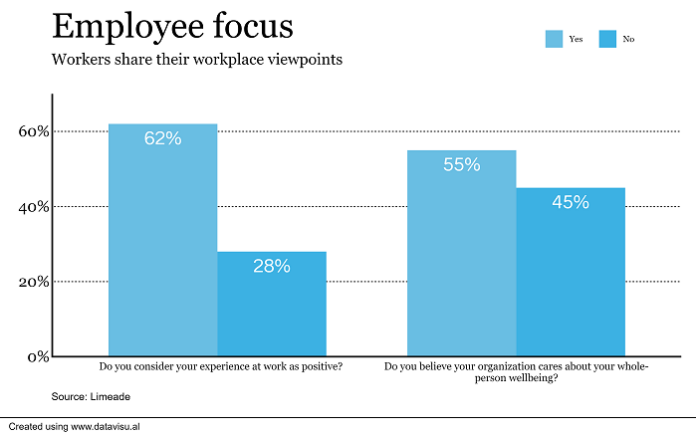Even before the phrase “employee experience”–let alone its abbreviation, EX–became a standard part of the HR lexicon, computer giant IBM forged a reputation as a leader in understanding what its workforce needed to become happier and more productive. Starting with a 2002 companywide exercise called a Values Jam that allowed rank-and-file employees to craft a new mission statement for the tech behemoth, IBM sharpened a reputation for two-way communication, including wide-open chats in which rookie programmers could email the CEO directly.
But the firm’s penchant for ground-up chatter proved especially valuable when the employee experience was upended by the 2020 arrival of the coronavirus pandemic, which meant that the vast majority of IBM’s 345,000 worldwide employees were now working from home and coping with a brave new world, much like their kids in online classrooms next door amid a flurry of Zoom conferences.
Related: How do you define EX? Create ‘the irresistible organization’
Weeks into the COVID-19 office shutdowns, an online conversation about these new stresses of juggling family responsibilities while working from home expanded until it included top executives and was worked into a groundbreaking document called the IBM Work from Home Pledge. The document made it clear that it was OK to bolt from an online meeting to deal with a household crisis or to turn the camera off for some meetings–or that it was bad form to make fun of a co-worker’s wall hangings.
Related: Here’s a look at today’s fast-changing EX technology

“With more people taking more home”–even before the pandemic–”we’d always focused on the idea of work/life integration as a key pillar,” says Damon Deaner, IBM’s director of employee experience and design. “But since the pandemic, we’ve shifted our focus away from one kind of [workplace] journey and more into wellness and wellbeing, both physical and mental.”
The unique pledge made IBM a trailblazer in the corporate COVID response. But the document, and the collaborative process that created it, also showed Big Blue to be on the cutting edge of a broader rethinking of what employee experience really means moving into an eventual post-pandemic workplace. The keys include not just the new emphasis on the health–both physical and mental–of workers but also a greater sensitivity toward understanding what they need to be happy.
Arguably, the pandemic has caused a dramatic change in what employee experience actually means to top HR executives, many of whom began embracing the concept as a logical progression from customer experience around the mid-2010s. At first, tech companies such as Airbnb–which branded its entire people-management operation as “Employee Experience”–largely perceived EX as centered on remaking the offices where workers spent so much of their time, with a focus on open space and fostering spontaneous interactions, including recreation (remember foosball tables?) or weekly ethnic lunches.
The pandemic not only scrambled the logistics–Zoom meetings created more issues around privacy than spontaneity–of the work experience but also shone a spotlight on more existential concerns. Both top human resource executives and experts agree the new workplace puts employee experience at the center of business strategy, with firms not only listening more closely to their employees but making changes based on what they hear, all toward promoting a culture of wellbeing.
See also: Why employee experience should be a holistic, personalized journey
Andy Walker, the managing director for talent & rewards at Willis Towers Watson, says his consultancy’s surveys have found that, in the first 18 months or so of the pandemic, employer perceptions of the importance of employee experience have skyrocketed from 52% to 92%. “The pandemic has essentially created an employee-experience stress test,” Walker says, explaining that the drastic measures many firms took to keep their doors open during the initial harsh lockdowns of 2020 demanded a stronger focus on the human needs of workers along for that fraught journey.
Indeed, the drastic, sudden interruption of daily routines created a situation in which millions of workers suddenly re-thought everything–from their career choices to where they should live. The pivot point of the pandemic caused some Baby Boomers to retire earlier than planned, while other workers went back to school or changed professions. Suddenly, the companies that offered these restless workers the most compelling reasons to stay onboard would gain a business advantage–not just from that continuity but from employee enthusiasm.

“Rather than look at the workforce as a body of employees, the focus now–when I think of employee experience–should be looking to the level of the individual,” says Elizabeth Kiehner, vice president for enterprise transformation at Capgemini Invent, who has written about the post-coronavirus workplace for Forbes and other outlets. “For a smaller HR department,” she notes, “that can be daunting.”
For Kiehner, the solution is taking a more active approach to engaging employees–through better use of data on workers’ issues and concerns, as well as executive training to help company leaders better help individuals.
Alexandra C. Wood, an associate partner at McKinsey and Co.–which produced a 2020 report titled COVID-19 and the employee experience: How leaders can seize the moment–agreed that open communication among executives and their workers is critical. But she also stressed “making sure that leaders turn employees’ concerns into action and share progress. So often, we see organizations launch surveys or ask for feedback but fail to communicate results and action plans–this only makes matters worse.”



